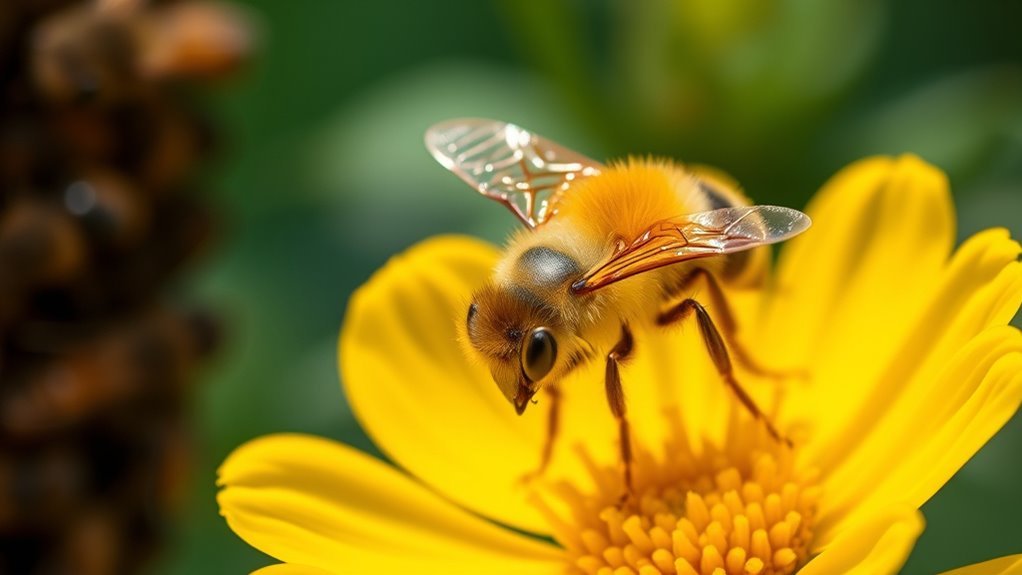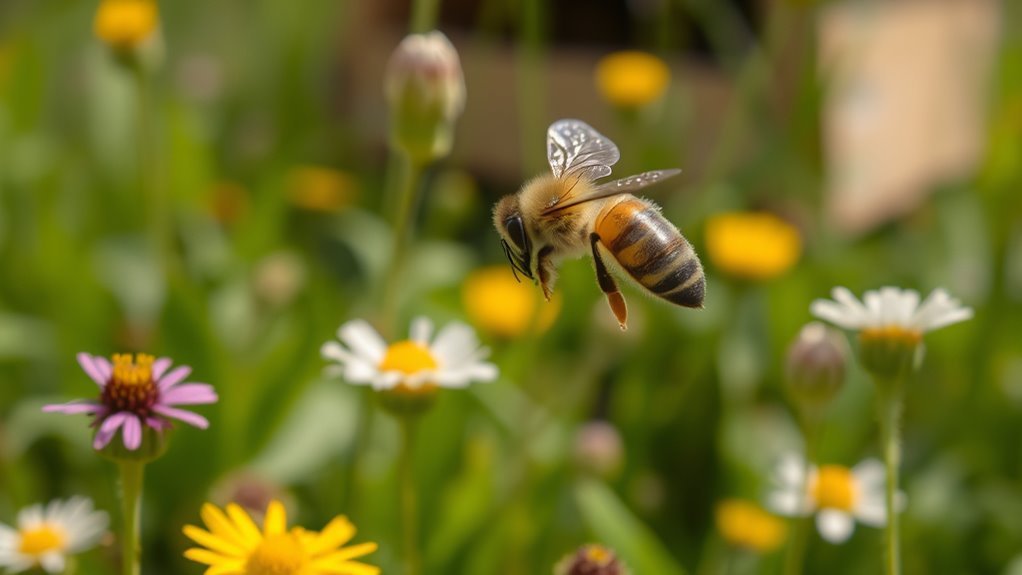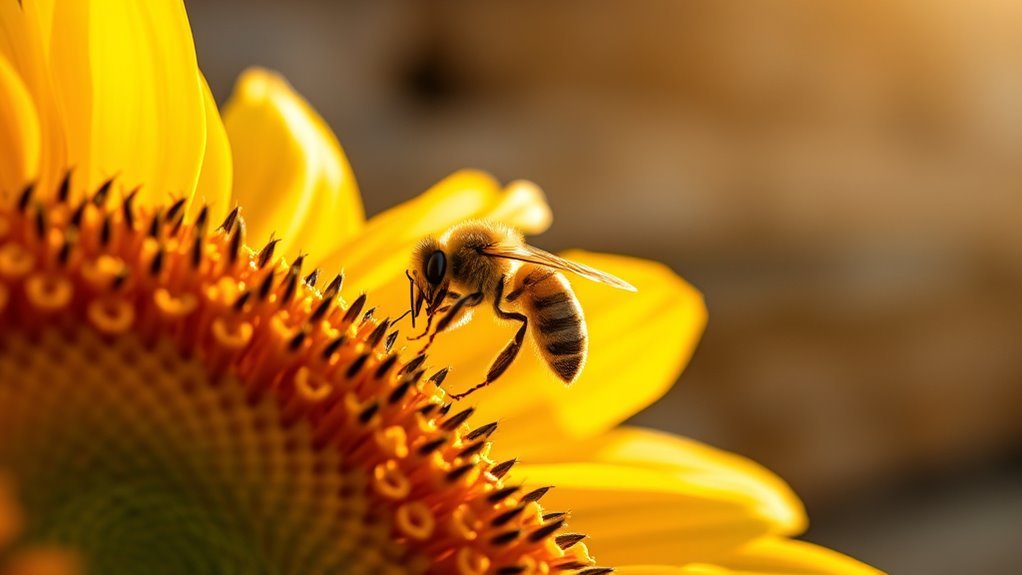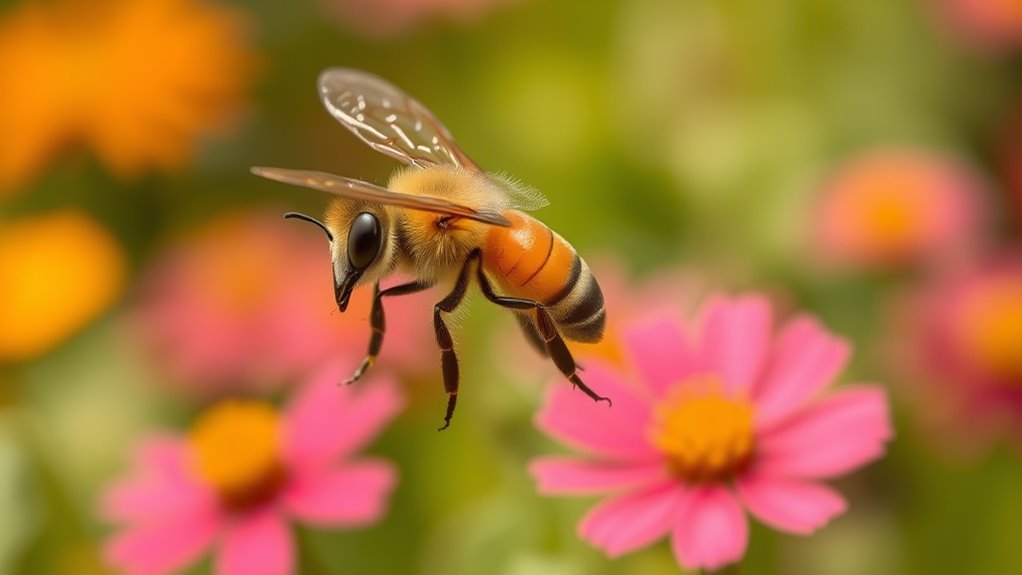A drone bee typically lives about eight weeks during active seasons, but its lifespan varies with environmental factors, nutrition, and hive conditions. Most drones perish after mating flights, as mating causes physical rupture, ending their life immediately. Unmated drones may survive slightly longer but are often expelled before winter to conserve resources. Seasonal shifts and hive resource availability critically influence their longevity. Understanding these dynamics reveals more about drones’ essential role in colony survival and genetic diversity.
The Role of Drone Bees in the Hive

Although drone bees don’t participate in foraging or hive maintenance, their primary role is essential for the colony’s reproduction: they exist to mate with a queen from another hive, ensuring genetic diversity and the continuation of the species. You should understand that within the drone hierarchy, each male bee competes to fulfill this reproductive duty, engaging in complex mating rituals characterized by flight patterns and timing synchronized with the queen’s nuptial flight. These rituals are critical, as successful mating occurs in mid-air, and only the strongest drones contribute genetically to new colonies. This natural system grants you insight into how freedom—in the form of choosing ideal mates—drives evolutionary success. Observing this precise division of labor highlights the drone’s indispensable role within the hive’s reproductive strategy.
Typical Lifespan of a Drone Bee

When you consider the drone bee’s specialized role in reproduction, you’ll find that their typical lifespan is relatively short compared to worker bees and queens. Drone bee anatomy, particularly their larger eyes and robust bodies, equips them for mating flights rather than extended hive duties. Their behavior centers on seeking queens during nuptial flights, a demanding task that often culminates in death upon successful mating. Typically, drones live about 8 weeks during active seasons, but many perish sooner due to environmental pressures or hive dynamics. Unlike worker bees, drones don’t participate in foraging or hive maintenance, which also influences their shorter longevity. Understanding this precise lifespan helps you appreciate how drone bee anatomy and behavior are finely tuned for reproductive success at the cost of long-term survival.
Factors Influencing Drone Bee Longevity

Because drone bees have a reproductive role that demands intense energy expenditure, several factors directly impact their longevity. When you consider drone bee lifespan, both environmental factors and genetic traits play vital roles. You’ll find that drones exposed to ideal conditions tend to live longer, while those facing stress or resource scarcity have shortened lives. Additionally, inherited genetic traits influence their resilience and overall health, shaping how long they can sustain their reproductive duties.
Key factors influencing drone bee longevity include:
- Availability of nutritional resources within the hive
- Exposure to pesticides and pollutants
- Genetic predispositions affecting immunity and stamina
- Hive temperature and humidity stability
- Frequency of mating flights and associated energy costs
Understanding these variables helps you grasp the delicate balance sustaining drone bee life.
Seasonal Variations in Drone Bee Life Expectancy
Since drone bee activity and environmental conditions shift throughout the year, their life expectancy varies considerably with the seasons. You’ll notice that during spring and summer, increased temperatures and abundant floral resources promote heightened seasonal behavior, extending drones’ active lifespan. Conversely, as environmental factors such as declining temperatures and reduced food availability emerge in autumn, drone longevity diminishes sharply. You must consider that drones are typically expelled from hives before winter to conserve resources, drastically shortening their lifespan during colder months. This cyclical pattern reflects adaptations to seasonal environmental cues, optimizing colony survival. Understanding these fluctuations helps you appreciate how drones’ life expectancy is intricately tied to the dynamic interplay of seasonal behavior and environmental factors throughout the year.
The Mating Process and Its Impact on Drone Lifespan
Although drone bees primarily exist to mate with queen bees, this reproductive act profoundly influences their lifespan. The mating ritual is brief but intense; drones die shortly after copulation due to physical rupture. This ultimate sacrifice guarantees the queen gains genetic diversity, crucial for colony resilience. As you observe, the process reflects an evolutionary trade-off between reproductive success and individual survival.
Consider these points about mating’s impact on drone lifespan:
- Mating occurs mid-flight in drone congregation areas.
- Post-mating, the drone’s endophallus detaches, causing fatal injury.
- Only a small percentage of drones successfully mate.
- Genetic diversity from multiple drones enhances colony health.
- Unmated drones can live several weeks, unlike mated ones.
Understanding this reveals the delicate balance between freedom and biological constraints in bee societies.
How Drone Bees Are Managed by Worker Bees
When you observe a hive, you’ll notice that worker bees play a critical role in regulating the drone population to maintain colony balance. This drone management involves precise assessment of resource availability and seasonal conditions. Worker bees cooperate by selectively feeding drones and controlling the number of drone brood cells they rear. During resource scarcity or late seasons, workers may actively remove drone larvae or eject mature drones to conserve energy. This cooperation guarantees the colony’s survival by preventing overpopulation of drones, which are energetically costly. Furthermore, workers regulate drones’ access to food and space, directly influencing drone lifespan. Your understanding of this intricate worker cooperation reveals how colony dynamics depend on disciplined drone management, optimizing reproductive potential without compromising the hive’s overall health and freedom to adapt.
The Importance of Drones for Colony Survival
You need to understand that drone bees play a critical role in reproduction by fertilizing the queen, ensuring genetic diversity within the colony. Without successful mating, the hive’s ability to produce healthy offspring diminishes, directly impacting overall hive health. Recognizing the importance of drones helps explain why their lifecycle and management are essential to colony survival.
Role in Reproduction
Since drones are the sole male bees in a colony, their primary role centers on reproduction, specifically mating with virgin queens to secure genetic diversity and colony survival. You’ll find that their mating rituals are highly specialized, involving flight to drone congregation areas where reproductive strategies maximize successful mating opportunities. This guarantees the queen’s sperm storage is diverse, bolstering colony resilience.
Consider these critical aspects of drone reproductive roles:
- Participation in synchronized mating flights at specific times
- Competition among drones to access queens
- Transfer of genetic material to secure colony adaptability
- One-time mating event leading to drone’s death
- Contribution to the genetic pool essential for colony evolution
Understanding these reproductive dynamics highlights how drones empower the hive’s freedom to thrive through genetic variation.
Impact on Hive Health
Although drones don’t gather nectar or defend the hive, their presence is essential for maintaining the genetic health and long-term viability of the colony. You need to understand that drone behavior directly influences hive dynamics, particularly through mating flights that enable genetic diversity. This diversity reduces vulnerability to diseases and environmental stressors, promoting colony resilience. Without healthy drones exhibiting typical mating behavior, the queen’s fertilization success declines, threatening hive survival. In addition, drones contribute to hive social structure by signaling reproductive readiness, which affects worker bee activity and resource allocation. So, even though drones seem passive, their role in sustaining genetic variation and regulating hive dynamics is critical. Recognizing this helps you appreciate how each drone’s life cycle impacts the freedom and adaptability of the entire colony.

